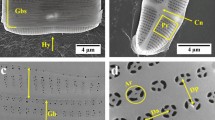Abstract
The paper aims to expand the application of natural marine algae. Marine diatoms, which have intricate frustule structures, can serve as bio-template for preparing three-dimensional materials. A simple and effective approach to synthesize the corrugated agaric-like biomorphic TiO2 templated with frustule of Coscinodiscus sp. is reported. In the sol-gel preparation process, the titania-coating on the frustule is prepared through the deposition and condensation with the aid of acetylacetone (acac) as a controlling agent to make the precursor Ti(BuO)4 hydrolyze slowly. The as-prepared titania-coated frustule and biomorphic TiO2 is characterized by scanning electron microscopy (SEM) attached with energy dispersive X-ray spectrometer (EMAX) and X-ray diffraction (XRD). The microstructure of the corresponding titania nanoparticles appears to be sphere with the diameters distributed around 10–20 nm. The templating process is repeated for three cycles. Subsequently, the three-dimensional freestanding corrugated agaric-like biomorphic TiO2 structure is obtained by a selective removal in the NaOH solution. As far as we known, the 3D freestanding corrugated agaric-like biomorphic TiO2 with greatly increased surface area is obtained for the first time.
Similar content being viewed by others
References
Auffan, M., Pedeutour, M., Rose, J., Masion, A., Ziarelli, F., Borschneck, D., Chaneac, C., Botta, C., Chaurand, P., Labille, J., and Bottero, J. Y., 2010. Structural degradation at the surface of a TiO2-based nanomaterial used in cosmetics. Environmental Scicence & Technology, 44 (7): 2689–2694.
Blanchard, J., Ribot, F., Sanchez, C., Bellot, P. V., and Trokiner, A., 2000. Structural characterization of titanium-oxo-polymers synthesized in the presence of protons or complexing ligands as inhibitors. Journal of Non-Crystalline Solid, 265: 83–97.
Butcher, K. S. A., Ferris, J. M., Phillips, M. R., Wintrebert-Fouquet, M., Jong Wah, J. W., Nemanja Jovanovic, Vyverman, W., and Chepurnov, V. A., 2005. A luminescence study of porous diatoms. Materials Science and Engineering C, 25: 658–663.
Chen, X. B., and Mao, S. S., 2007. Titanium dioxide nanomaterials: synthesis, properties, modifications, and applications. Chemical Reviews, 107: 2891–2959.
Dudley, S., Kalem, T., and Akinc, M., 2006. Conversion of SiO2 diatom frustules to BaTiO3 and SrTiO3. Journal of the American Ceramic Society, 89: 2434–2439.
Fang, Y. N., Wu, Q. Z., Dickerson, M. B., Cai, Y., Shian, S., Berrigan, J. D., Poulsen, N., Kröger, N., and Sandhage, K. H., 2009. Protein-mediated layer-by-layer syntheses of freestanding microscale titania structures with biologically assembled 3-D morphologies. Chemical Materials, 21: 5704–5710.
Feng, X. J., Zhu, K., Frank, A. J., and Mallouk, T. E., 2012. Rapid charge transport in dye-sensitized solar cells made from vertically aligned single-crystal rutile TiO2 nanowires. Angewandte Chemie, 124: 1–5.
Gell, P. A., 1997. The development of a diatom database for inferring Lake Salinity, Western Victoria, Australia: towards a quantitative approach for reconstructing past climates. Australian Journal of Botany, 45: 389–423.
Guillard, R. R. L., and Ryther, J. H., 1962. Stichochrysis immobilis is a diatom, not a chrysophyte. Canadian Journal of Microbiology, 8: 229–239.
Haenle, M., Fritsche, A., Zietz, C., Bader, R., Heidenau, F., Mittelmeier, W., and Gollwitzer, H., 2011. An extended spectrum bactericidal titanium dioxide (TiO2) coating for metallic implants: in vitro effectiveness against MRSA and mechanical properties. Journal of Materials Science: Materials in Medicine, 22: 381–387.
Hafez, H. S., 2009. Synthesis of highly-active single-crystalline TiO2 nanorods and its application in environmental photocatalysis. Materials Letters, 63: 1471–1474.
Jeffryes, C., Gutu, T., Jiao, J., and Rorrer, G. L., 2008. Metabolic insertion of nanostructured TiO2 into the patterned biosilica of the diatom Pinnularia sp. by a two-stage bioreactor cultivation process. Acs Nano, 2(10): 2103–2112.
Jeffryes, C., Gutu, T., Jiao, J., and Rorrer, G. L., 2008. Peptide-mediated deposition of nanostructured TiO2 into the periodic structure of diatom biosilica. Journal of Materials Research, 23: 3255–3262.
Jia, Y. X., Han, W., Xiong, G. X., and Yang, W. S., 2008. Layer-by-layer assembly of TiO2 colloids onto diatomite to build hierarchical porous materials. Journal of Colloid and Interface Science, 323: 326–331.
Losic, D., Mitchell, J. G., and Voelcher, N. H., 2009. Diatomaceous lessons in nanotechnology and advanced materials. Advanced Materials, 21: 2947–2958.
Losic, D., Rosengarten, G., Mitchell, J., and Voelcker, N. H., 2006. Pore architecture of diatom frustules: potential nanostructured membranes for molecular and particle separations. Journal of Nanoscience and Nanotechnology, 6: 982–989.
Losic, D., Short, K., Mitchell, J. G., Lal, R., and Voelcker, N. H., 2007. AFM nanoindentations of diatom biosilica surfaces. Langmuir, 23: 5014–5021.
Losic, D., Triani, G., Evans, P. J., Atanacio, A., Mitchell, J. G., and Voelcker, N. H., 2006. Controlled pore structure modification of diatoms by atomic layer deposition of TiO2. Journal of Materials Chemistry, 16: 4029–4234.
Okazaki, Y., Ito, Y., Kyo, K., and Tateishi, T., 1996. Corrosion resistance and corrosion fatigue strength of new titanium alloys for medical implants without V and A1. Materials Science and Engineering A, 213: 138–147.
Park, J. A., Moon, J., Lee, S. J., Kim, S. H., Zyung, T., and Chu, H. Y., 2010. Structure and CO gas sensing properties of electrospun TiO2 nanofibers. Materials Letters, 64: 255–257.
Author information
Authors and Affiliations
Corresponding author
Rights and permissions
About this article
Cite this article
Zhang, Q., Chen, R. & Li, L. Synthesis of three-dimensional agaric-like biomorphic TiO2 by a facile method with Coscinodiscus sp. frustule. J. Ocean Univ. China 11, 507–510 (2012). https://doi.org/10.1007/s11802-012-2031-6
Received:
Revised:
Accepted:
Published:
Issue Date:
DOI: https://doi.org/10.1007/s11802-012-2031-6




